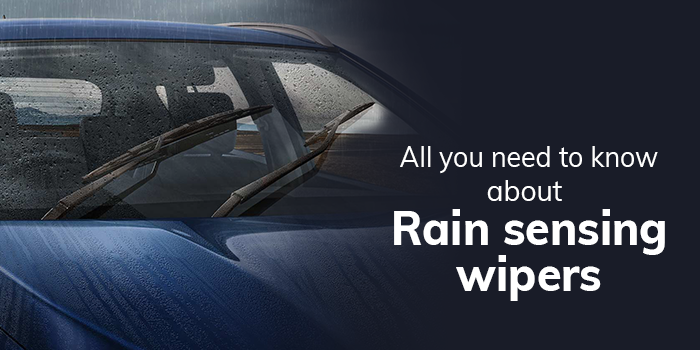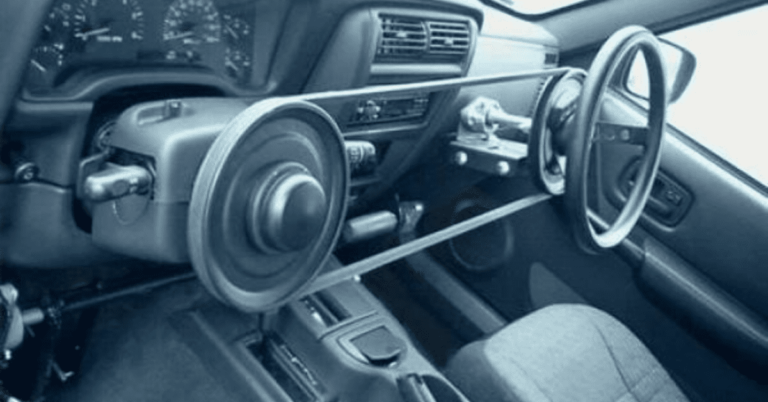
One of the first things we reach out for when it is raining while driving is the windshield wipers. The windshield wiper is an essential device to keep rain droplets off the windscreen in order to have a clear view of the road ahead. It can sometimes be a hassle to locate the windshield wiper stock and turn it on at the right speed. However, some modern cars have an elegant solution in the form of automatic rain sensing wipers.
Rain sensing wipers are a result of automotive engineers trying to make the life of the driver more convenient. You don’t have to take your eyes off the road if it starts to rain, and you can concentrate on the road ahead during a thunderstorm. Once it stops raining, the wipers automatically turn off so you don’t have to bother with the control stock. The intermittent speed of the wipers is also automatically controlled so that the wipers work faster when it rains harder and slower when it is just drizzling.
History of the windshield wiper
When windscreen wipers were first installed on automobiles at the beginning of the century, they were manually operated and required the driver to turn the wiper stalks by a lever placed in the cabin. It was hard work and the lever had to constantly be turned as long as it was raining.
With the advent of electric motors cars, the process got a little easier because the driver had to just flick a switch to operate the windshield wipers. As technology advanced and electronics were introduced into cars, there were options to increase or decrease the speed of the wipers depending on how much moisture was on the windshield. Still, the driver had to constantly adjust the controls and turn them on or off when required.
Attempts at a fully automatic wiper system adjusted the intermitted speed by using special electrical resistors to send varying currents to the electric motor. Modern technology has made things much easier for the driver through the use of sensors, electronics and electrical systems.
Also checkout Wiper Blades Guide: Learn About Type, Buying Guide & FAQs
Rain sensing wipers – How do they work?
Automatic rain sensing wipers are found in most modern cars and are not exclusive to luxury vehicles like in the past. Japanese hatchbacks often make use of these advanced electronic gadgets and have been available since the 90s. They are often combined with automatic headlamps that switch on automatically when it gets too dark.
Rain sensing auto wipers make use of an LED sensor fitted behind the windshield in the space between the rearview mirror. The LED sensor can detect the amount of rainfall, snow or moisture which falls upon the windshield. The LED sensor has infrared beams that are emitted toward the windshield. There is a central photodiode that completes the rain sensing components.
The infrared light which is focused on the windshield is reflected back onto the central photo sensor. With moisture on the windshield in the form of rain droplets, ice or snow, the infrared beams are scattered at various angles and do not reflect back to the sensor. When the sensor detects a low level of reflected infrared light, it sends an electrical signal to an electronic computer control unit. The computer analyses the signal and then powers the windshield wipers to start wiping the moisture off the windscreen.
Also read OEM vs Aftermarket – Which is better?
The photo sensor is very sensitive and can detect the level of moisture on the windscreen depending on the strength of the reflected infrared LED beams. The harder the rain falls, the faster the windshield wipers work to clear the view. When the rain sensing system detects that the rain has reduced, it will automatically slow down the speed of the wipers and turn off the system when conditions are dry.
Rain sensing wipers cost Rs.2000 – 3000 for an aftermarket instalment and are compatible with most car models and variants.
How to use rain sensing wipers?
Rain sensing detects rain drops on the windshield and automatically activates it to clear the windscreen. Once the system switches on, the driver does not to adjust the speed of the wipers or switch off the system when it stops raining.
Remember to turn the system off when washing the car because it may automatically switch on when you pour water on the windscreen and could get damaged.
The first step is to switch on the system from your steering lever stock. There will be an option to either push the lever up or down (the wiper stock should have auto-on with a wiper symbol on it).
Twist the rotary knob to set the correct sensitivity you need. When the automatic rain sensing wipers are in high sensitivity mode, they will activate with only a few drops of water on the windscreen. On a low-sensitivity setting, the wipers will only turn on when there is a large amount of moisture on the windscreen.
You should receive a confirmation that the auto rain sensing wipers have been activated on your infotainment screen or instrument binnacle. The headlamps may also be on auto setting and should switch on along with the rain sensing wiper system to increase visibility.
Also read Which Mirror Is Used in the Headlights of a Car?
Keep the rain sensing wiper system in good condition
The rain sensing auto system is sensitive to anything that falls upon the windshield such as dirt, leaves, ice, mist or insects.
Driving in these conditions may cause the rain sensing wiper system to behave erratically, switching on when it doesn’t rain or switching off when there is moisture on the windshield.
It is important to keep your windshield clean at all times to avoid smearing and malfunctioning of the rain sensing wiper system.
Keep the sensitivity level low to avoid the wipers being activated unnecessarily. When the wipers do need to clear moisture, set it on a high-speed level so that the windshield is cleaned well.
Switch the auto rain sensing wiper off if you don’t expect rain and are driving in dry conditions. Use a good windscreen cleaning liquid and a microfiber cloth for car to clear all dirt and moisture from the windscreen.
If you experience problems with the rain sensing wiper system, then replace the wiper blades with new ones.
Why are rain sensing wipers not working after windshield replacement?
The rain sensing wipers may malfunction sometimes after a windshield replacement. The sensor is designed to work with a certain windshield because it relies on sending LED infrared beams towards the windshield that need to be reflected back. The new windshield must have the same specifications as the old windshield to be able to reflect light in the same way.
You may have to replace the rain sensor when a new windshield is installed. Sometimes the sensor device has to be recalibrated to start working as usual. The new windshield may have different refractive properties that should be compatible with the sensor.
Some steps you can take to ensure it works perfectly by car windshield cleaner. Remove any smears or oily films especially around the sensor area in order for it to have an error-free operation.
Ensure that the rain sensor is aligned properly behind the windshield and that it hasn’t peeled off, is loose or hanging. If so, reattach the sensor in its proper position using glass adhesive.
The electronic system may have to be reset to start working with a new windshield. Since the system has to be disconnected when replacing the windshield, it will have to be reset and recalibrated to work after being connected and powered up.
Check all the electrical connections, fuses and electronic components and ensure they are working fine.
Also read The Difference Between A Car Wash And Car Detailing?
Conclusion
Rain sensing wipers constitute modern technology that is now a common feature on cars in all price brackets. The system can also be installed aftermarket for a reasonable cost to make the driving experience more convenient.
Rain sensing wipers automatically detect rain, snow, and moisture and activate to clear the windscreen. They automatically adjust the wiper speed depending on the amount of moisture present so the driver can concentrate on the road.
We can expect to see new, innovative features such as rain sensing wipers on our cars that work along with automatic headlamps and connected features that keep us informed about the status of the car.
This article’s aim is to educate readers about the technology behind rain sensing wipers and information regarding the system. Have a look at our other articles such as ways to diagnose faulty wipers or visit Carorbis Blog for more.
Frequently Asked Questions
Q1. How rain sensing wipers work?
Ans. Rain sensing wipers have sensors that detect the amount of moisture on the windshield and automatically turn the wipers on to clear the windscreen. The speed of rain sensing wipers automatically increases when they detect large amounts of moisture on the windshield. The rain sensor is located in the area behind the rear-view mirror attached to the windscreen. The sensors that detect moisture are very sensitive and can be triggered if mist settles on the windscreen or dirt fall upon it. Lower the sensitivity level on your automatic rain sensing wipers when you are driving in foggy, icy or winter conditions.
Q2. What are rain sensing wipers?
Ans. Rain sensing wipers are a convenient way to keep your windshield free from moisture when it rains. The rain sensing device is placed behind the windshield and emits infrared light beams that reflect off the glass and back to the sensor. When there are water droplets present on the windshield, the infrared light beam is reflected back at a different angle and doesn’t hit the sensor properly. This triggers the rain sensing wipers to turn on and remove the water droplets from the windshield. The sensor switches off the rain sensing wipers when the windscreen is clear.
Q3. How to turn on rain sensing wipers Ford?
Ans. Rain sensing wipers are a very useful feature to have on your Ford car because they allow you to concentrate on the road and have the wipers turn on automatically when it rains. To turn on your automatic rain sensing wipers, identify the windshield wiper lever and raise it to the first position. This switches on the rain sensing wipers and the infrared sensor will be activated to detect moisture. If it starts to rain, the rain sensing wipers will automatically turn on and adjust their speed according to the amount of moisture on the windshield. The sensitivity of the wipers can be adjusted by turning the inner ring on the stalk up or down for higher or lower sensitivity. A high sensitivity setting will switch on the wipers even with the smallest amount of moisture detected.
Q4. How to turn on rain sensing wipers Mercedes?
Ans. Mercedes Benz has rain sensing wipers that automatically turn on when it rains. The wiping frequency is automatically regulated, making driving easy and convenient in bad weather. This feature is available on a number of Mercedes Benz models. The rain sensing wipers automatically switch on when it rains with the help of a moisture-detecting sensor behind the windshield. The wiper stock must be activated by lifting or turning the knob so that the sensor knows it needs to detect rain droplets on the windscreen. The rain sensing wipers will automatically stop when there is no moisture on the windshield. The rear windscreen wiper also automatically switches on during inclement weather, or when the transmission is shifted into reverse.
Q5. Toyota rain sensing wipers not working?
Ans. First, clean the surface of the windshield and remove any moisture or dirt, especially around the sensor area. Ensure the sensor is properly fixed in position and that the infrared beam is not misaligned. Clean the wiper on/off switch with WD40 by turning the knob and spraying the electrical cleaner in the contacts. Flick the switches several times and allow them to dry off. Now that this step is complete, spray water from a watering can onto the windshield and check if the rain sensing wipers automatically turn on. If not, have a certified mechanic take a look at the system because it could be a problem that is not easily fixed.








